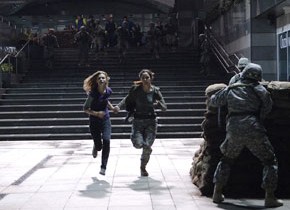Scared of Schengen: Euro-Horror Today
March 27 to April 6, 2015
Without film, the world would remain unseen; it would merely be under observation. Europe would be even darker without horror films. Europe’s Schengen space, well-defined and fenced up, views itself by blocking off its moments of horror and violence. Horror cinema re-introduces them into the picture, as demonstrated by this series of 15 recent European films – a post-script to the Film Museum’s extensive retrospective on the horror genre staged in 2013 and 2014.
At first, it seems as if a spirit of achievement and performance reigns supreme. Then horror takes over – takes over the image, the story, our senses. This can happen with shrill action in pitch-black darkness, when an all-female group of young, adventurous cave-climbers descend into the terrors of gendered violence and ethnicized projections in Neil Marshall’s The Descent. It can also happen slowly, with detailed images of everyday life, as in Dans ma peau, the first feature by actress-director Marina De Van. The film places us in the unbearable bodily presence of a careerist French employee of a global corporation; after wounding her leg by accident, she starts cultivating a secret passion for cutting and tasting her own flesh.
"European Spirit" embarks on watery journeys – in Christian Petzold’s Yella, a road-movie mutating into a Carnival of Capital’s Souls, or in Nicolas Winding Refn’s Valhalla Rising, with a group of Vikings on a death-drive to the Holy Land (America) – while zombified urban masses assemble in disturbing ways: quietly, as objects of normalized exclusion, in Robin Campillo’s Les revenants; and frenetically in London and Berlin, facing the Army’s crosshairs (28 Weeks Later) or a fat guy from Vienna (Rammbock). There is also the lasting presence of a monstrous violence that once ruled over the country – in Pan’s Labyrinth, Guillermo del Toro’s fantastic family melodrama set in Fascist Spain, and in Trollhunter, a satirical Mockumentary which conjures up charismatic heroes and emblematic creatures from Norway’s national heritage.
Rather than the pathos of transgression or the joys of cult cinema, what is at stake here are the literally eye-popping images of politics. In horror mode, genre cinema can be as conceptual as documentary films can be uncanny. Joerg Burger’s Exploration turns the shot-reverse-shot mode of a brief conversation into a testing ground for creepiness. Michael Palm’s minimalist Laws of Physics and the paranoid mystery thriller Leftbank (about the twisted ways of Antwerp gentrification) both show us a haunted house with a hole in its ground – the common European home, as the phrase once went: a habitat shared with specters, voices, atmospheres.
And sometimes, neighbours join together in the house, meeting at the lines of class, gender and ethnic demarcations, without ignoring these divisions. They light a few joints and fireworks, in solidarity against those who try to invade their South London council estate, be they extraterrestrial wolf monsters or armed police. Such things can happen when aliens Attack the Block. The tagline for Joe Cornish’s gory SciFi-satire was "Inner City and Outer Space". Between inside and outside, we see red lines – sitting still, scared of Schengen.
The series was curated by Drehli Robnik and is accompanied by a two-day conference with lectures by film and cultural scholars Johannes Binotto, Karin Harrasser, Christine Lötscher, Michael Palm, Drehli Robnik and Michaela Wünsch.
